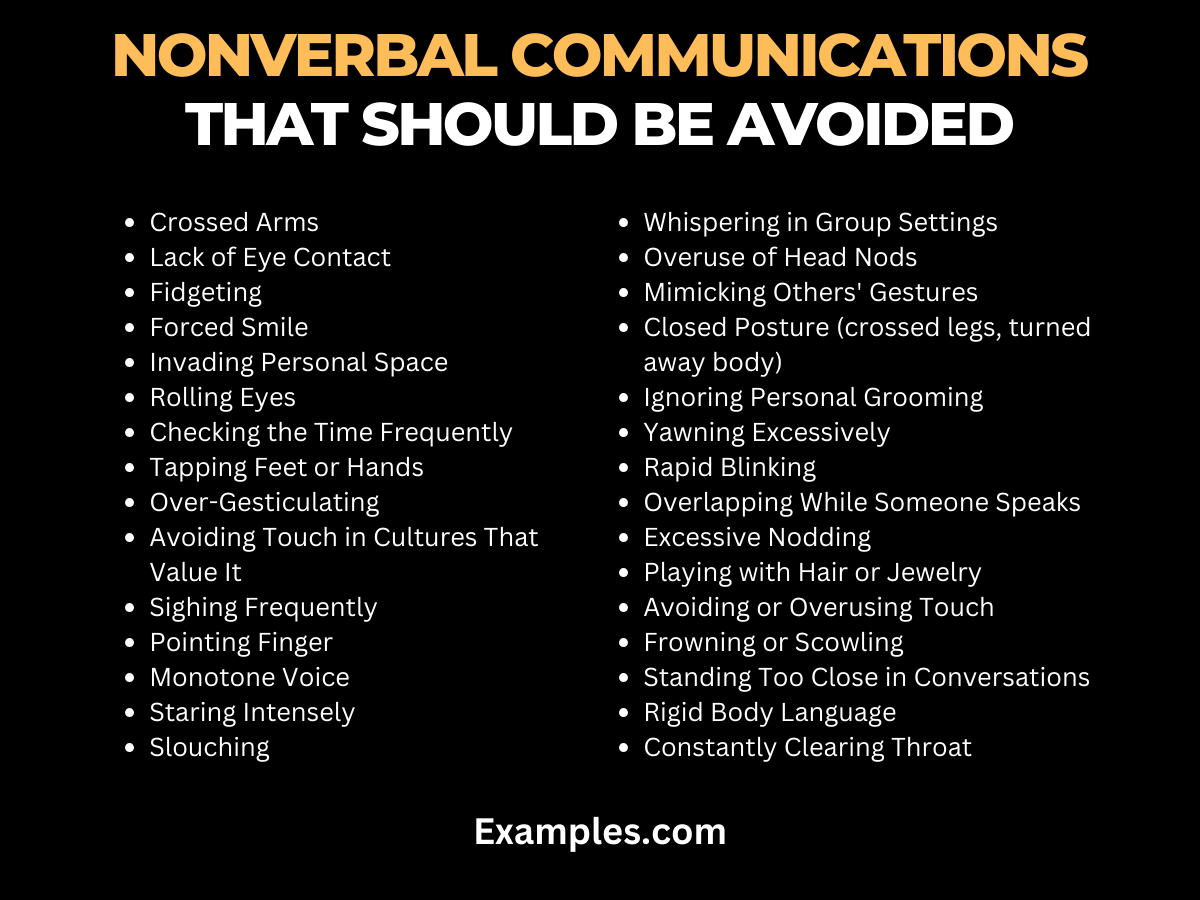30+ Nonverbal Communications that Should be Avoided
Navigating the intricate world of nonverbal communication is crucial, yet challenging. This comprehensive guide dives into the types of nonverbal communications that should be avoided. With real-world examples and expert insights, we unravel the complexities of “Non Verbal Communication,” helping you to avoid common pitfalls. Enhance your understanding of unspoken cues and refine your communication skills to foster more effective and meaningful interactions in both personal and professional settings.
Nonverbal Communications that Should be Avoided

Crossed Arms
This gesture often indicates defensiveness, resistance, or self-protection. In a conversation, crossed arms can create a barrier, signaling discomfort or disengagement. It may also reflect a person’s self-soothing behavior during stress. To improve, consciously lower or unfold your arms, adopting a more open stance. This change in posture can make you appear more approachable and willing to engage.
Lack of Eye Contact
Avoiding eye contact can suggest a lack of confidence, interest, or honesty. It can make interactions seem impersonal. However, it’s essential to understand cultural nuances, as eye contact norms vary globally. To improve, practice maintaining moderate eye contact, which conveys confidence and interest in the conversation without being too intense.
Fidgeting
Fidgeting, such as tapping fingers or shaking legs, often indicates nervousness, boredom, or impatience. It can be distracting and suggest a lack of focus or professionalism. To reduce fidgeting, become aware of your habits and practice stillness. Deep breathing can also help in managing nervous energy.
Forced Smile
A forced smile, lacking genuine emotion, can be perceived as insincere or disingenuous. It may be used to mask true feelings or to comply with social expectations. To improve, focus on aligning your facial expressions with your true feelings, which fosters authenticity in your interactions.
Invading Personal Space
Standing too close to someone can feel intrusive and uncomfortable, often perceived as aggressive or disrespectful. Personal space norms vary by culture. To improve, be mindful of cultural norms and observe the other person’s comfort level, adjusting your distance accordingly to maintain respectful interaction.
Rolling Eyes
Rolling eyes is a nonverbal gesture often interpreted as disrespect, sarcasm, or annoyance. It can undermine the effectiveness of communication, creating an impression of dismissiveness or lack of interest. This behavior is particularly detrimental in professional settings, where it can damage relationships and convey a lack of seriousness. Rolling eyes, whether intentional or habitual, can significantly impact how others perceive and interact with you.
Checking the Time Frequently
Frequently checking the time during conversations can be perceived as rude, implying that you are bored, uninterested, or impatient. This behavior disrupts the flow of communication and may make the other person feel undervalued. It’s especially counterproductive in meetings or personal interactions, where engagement and attentiveness are crucial.

Tapping Feet or Hands
Tapping feet or hands is often a sign of impatience, nervousness, or restlessness. This habit can be distracting to others and may convey a lack of composure or eagerness to end the interaction. In professional or social situations, it can detract from the effectiveness of your communication and potentially annoy others.
Over-Gesticulating
Using excessive gestures can overwhelm or confuse the audience, detracting from the message you’re trying to convey. While hand movements can be effective in emphasizing points, overdoing it may lead to misinterpretation or distraction. It’s important to strike a balance to ensure that your body language complements rather than overshadows your verbal communication.
Avoiding Touch in Cultures That Value It
In cultures where touch is an important part of communication, avoiding it can be interpreted as cold or distant. Touch, such as handshakes or gentle pats, can be a critical element in establishing trust and rapport. Understanding and respecting these cultural norms is crucial for effective communication and relationship building.
Sighing Frequently
Sighing often during conversations can signal frustration, boredom, or disengagement, potentially leading to misunderstandings. It’s an unconscious action that reflects internal emotions, sometimes interpreted negatively by others. Frequent sighing may create a barrier in communication, as it can be perceived as a lack of interest or annoyance. To improve, focus on expressing feelings verbally. Instead of sighing, articulate your thoughts and emotions to provide clarity and maintain positive communication dynamics.
Pointing Finger
Pointing a finger during conversations is often seen as aggressive or accusatory, leading to defensive reactions. It’s a nonverbal gesture that can escalate conflicts or create tension. This gesture may overshadow the message you’re trying to convey, affecting the effectiveness of communication. To improve, use open-handed gestures. Opt for gestures that are inclusive and non-threatening to foster a more positive and receptive environment.
Monotone Voice
A monotone voice lacks inflection and can convey disinterest or detachment, making it challenging to maintain the listener’s attention. It diminishes the effectiveness of verbal communication, as it fails to convey emotions or emphasize key points. This can lead to misinterpretation or disengagement. To improve, practice varying your vocal pitch. Use inflections to emphasize important points and express enthusiasm to engage your audience more effectively.
Staring Intensely
Intense staring can be intimidating and uncomfortable, potentially perceived as aggressive or overly intrusive. It can create a sense of unease and hinder open communication. In some cultures, intense staring is considered impolite or confrontational. To improve, practice softening your gaze. Strike a balance between maintaining eye contact and allowing natural breaks, to appear more approachable and respectful.
Slouching
Slouching conveys a lack of confidence or disinterest, impacting the perception others have of your engagement and professionalism. It can negatively influence the dynamics of interaction, making you seem less approachable or enthusiastic. To improve, focus on maintaining good posture. Good posture exudes confidence and shows engagement, enhancing your presence in any conversation or presentation.
Whispering in Group Settings
Whispering in group settings can create an atmosphere of exclusivity and secrecy, potentially alienating others who are not privy to the conversation. It can disrupt the group’s dynamics, leading to feelings of mistrust or discomfort among members. Often, it’s perceived as rude or disrespectful, as it implies that something is being deliberately hidden from others. To maintain a cohesive and inclusive group environment, open and transparent communication is essential.

Overuse of Head Nods
Excessive nodding during conversations can diminish the value of this gesture, making it seem less genuine or even robotic. While nodding is a universal sign of agreement or understanding, overdoing it may give the impression of disinterest, impatience, or a lack of genuine engagement in the conversation. It’s crucial to balance nodding with active listening cues to show true engagement and understanding of the discussion.
Mimicking Others’ Gestures
Mimicking others’ gestures can be perceived as mocking or insincere, especially if done excessively or without context. While mirroring can sometimes be a subconscious sign of rapport, overdoing it or doing it inappropriately can lead to discomfort or misunderstanding. It’s important to be aware of one’s own body language and ensure that gestures are natural and appropriate to the conversation.
Closed Posture (crossed legs, turned away body)
Adopting a closed posture, like crossed legs or a turned-away body, often signifies disengagement, defensiveness, or disinterest in the conversation or situation. This nonverbal cue can create a barrier between individuals, hindering open and effective communication. It’s crucial to be mindful of your posture in social and professional settings, as it greatly influences how others perceive your level of engagement and openness.
Ignoring Personal Grooming
Neglecting personal grooming can significantly impact first impressions and ongoing perceptions in both personal and professional contexts. Poor grooming habits can be interpreted as a lack of self-respect or consideration for others, potentially undermining one’s professionalism and ability to build positive relationships. Maintaining good personal hygiene and a neat appearance is fundamental to positive social interactions.
Yawning Excessively
Excessive yawning in conversations can be perceived as a sign of boredom or disinterest, which can be disrespectful to the speaker. It often occurs when one is tired or disengaged. To improve communication, it’s essential to ensure adequate rest before important interactions and to engage actively in the conversation. If yawning is unavoidable, politely explain that it’s not a reflection of disinterest.
Rapid Blinking
Rapid blinking can signal nervousness, stress, or dishonesty. It might distract or unsettle the person you’re communicating with. To manage this, practice relaxation techniques and be mindful of your blinking during conversations. Maintaining a steady, calm gaze can help project confidence and sincerity.
Overlapping While Someone Speaks
Interrupting or speaking over someone can be perceived as rude and disrespectful. It impedes effective communication by not allowing the speaker to fully express their thoughts. To improve, practice active listening, showing respect for the speaker’s time to talk, and wait for natural pauses before responding.
Excessive Nodding
While nodding signifies agreement or understanding, doing it excessively can seem disingenuous or as if you’re not genuinely engaged with the conversation. To enhance communication, nod only when you truly agree or understand, reflecting genuine engagement and respect for the conversation.
Playing with Hair or Jewelry
This habit can indicate nervousness or distraction and can detract from the speaker’s message. To communicate more effectively, be conscious of this habit and keep your hands still or use them constructively to gesture, aiding in better engagement and attentiveness in the conversation.
Avoiding or Overusing Touch
Touch is a powerful nonverbal communication tool, but its use varies significantly across cultures and individual comfort levels. Overusing touch can invade personal space and make others uncomfortable, while completely avoiding it can seem cold or unapproachable, especially in cultures where touch is a common part of communication. Understanding the cultural context and observing others’ reactions are key.
Frowning or Scowling
Frowning or scowling, often involuntary responses to negative emotions, can convey disapproval, anger, or frustration. This expression can be off-putting in communication, creating a barrier to open dialogue. Being conscious of one’s facial expressions and actively working to maintain a neutral or positive expression can significantly improve interactions.
Standing Too Close in Conversations
Personal space is an important aspect of nonverbal communication. Standing too close can be perceived as intrusive or aggressive, making others uncomfortable. This varies by culture; what’s considered too close in one culture might be normal in another. It’s important to be aware of these differences and observe personal space boundaries.
Rigid Body Language
Rigid body language, such as crossed arms or a stiff posture, can signal defensiveness, disinterest, or resistance to conversation. Adopting a more relaxed and open posture can make interactions more inviting and productive.
Constantly Clearing Throat
Frequent throat clearing can be distracting and may be interpreted as a sign of nervousness or disinterest. Addressing any underlying physical discomfort or nervous habits is crucial to improving this aspect of nonverbal communication.
In conclusion, understanding and avoiding certain nonverbal communications is essential for effective interpersonal interaction. This guide has explored various nonverbal cues that can negatively impact communication, such as invading personal space, excessive nodding, and rigid body language. By being mindful of these behaviors and adapting our nonverbal communication, we can foster more positive and productive interactions in both personal and professional environments.



